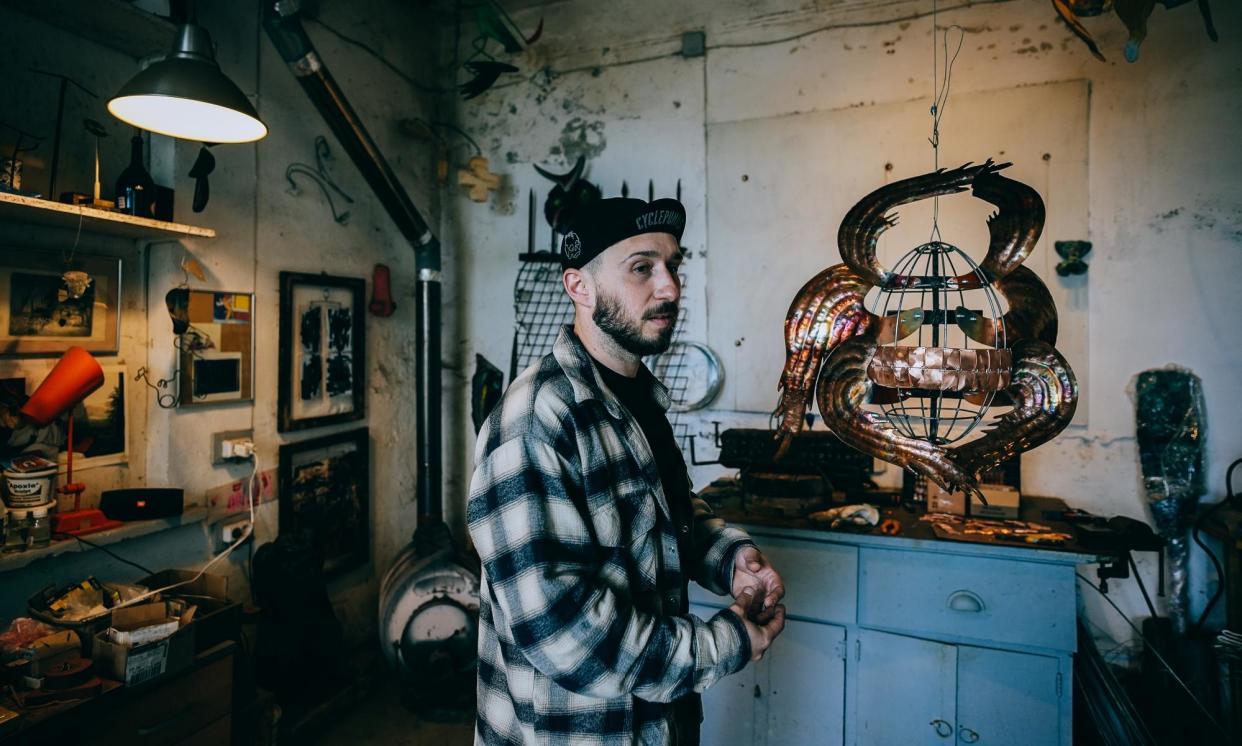‘We have a mission’: the Odesa artists refusing to abandon their studios

Behind a gate presided over by a taciturn doorman, on the shore of the Black Sea in Odesa, is a tumbledown ship repair yard. It is one of many industrial sites in Ukraine that fell into disuse after the fall of the Soviet Union, but in 2016 a community of young artists started cleaning up debris, renovating the old workshops and making studios.
Now, in 2024, when the city is regularly pounded by Russian missiles, its city streets empty of the tourists who once flocked to its historic centre, there are just a handful of artists willing to withstand the continuous threat to life.
Vasya Dmytryk is one of those artists who has chosen to remain, his studio, a few metres from the shoreline, a cosy cave of books, tools and metal sculptures suspended from the ceiling. On his workbench was a copper-and-steel sculpture recalling the shape of a drone. His plan is to exchange it for a real drone: “We have a very direct mission as artists,” he said. “Raising money for the army.”
“I am really rooted in Odesa,” he added. “The things that I love and care about are here. I felt I couldn’t live without it.”
At the start of Russia’s full-scale invasion, he had actively considered whether, if the city came to be occupied by the Russians, he would “stay and try to protect Ukrainian culture, or leave and try to present Odesa’s culture in other cities in Ukraine”.
His friend, the artist and curator Valeriia Nasedkina, said: “If everyone leaves, what then? With our presence here, we are insisting that we still exist.”
Nasedkina and her colleague Volodymyr Chyhrynets are curators at the Odesa National Fine Arts Museum, an elegant, neoclassical early 19th-century building in the centre of the city. In November, a cruise missile struck directly outside it, blowing the windows out, causing plaster to rain from the ceilings on to artworks, cratering the street and putting the administrative wing of the building out of action.
The bulk of the museum’s historical artworks had already safely evacuated. Dmytryk had been part of the volunteer effort that began on 24 February 2022: he cycled to the museum at dawn to play his role in the month-long work of taking down, packaging and safeguarding the huge, densely hung collection. At the time of the November 2023 attack, there was a temporary exhibition in the museum and a few very large 19th-century canvases remaining on the walls – some of which were physically blown out of their frames by the shock waves, said Nasedkina.
Despite the attack, the museum is still operating. Most of its elegant galleries are echoing and empty. “The last time it was like this was the second world war,” said Nasedkina. But some of the rooms hold temporary exhibitions by contemporary artists.
One of them is of delicate botanical watercolours of wildflowers – viper’s bugloss, alpine flax, mullein – made on the Bakhmut frontline by Borys Eisenberg, a former nurseryman who volunteered on the first day of Russia’s full-scale invasion and was killed in July 2023.
Another is by Dmytryk – a kinetic sculpture of nails from the boat repair yard, which swerve and collide in complex patterns as unseen magnets are activated below them. As they move, their rust creates a “drawing” on the sheet of paper they lie on – a metaphor, said Dmytryk, for the community of artists in Odesa.
A new exhibition is devoted to recent work by Dasha Chechushkova. A series of etchings, based on Goya’s critique of the follies of Spanish society, Los Caprichos, are hung along one wall. They were, she said, “a collection of symptoms of helplessness: depressions and thoughts which most of the time we can’t express to anyone else. The work is about loneliness, estrangedness.” At this point in the war, she said, the gulf in experience between Ukrainians – between those who had volunteered to fight, those who had not, those who were bereaved, those who had left – “has created this distance between people”.
One depicts an exhausted figure, with a text that translates as: “Since you can’t bear to blame yourself any more.” Another reads: “The sense of his muteness transforms the hero into a fool who does not know what else to do.”
Chechushkova, who is 24 and currently based in Kyiv, studied in Odesa. Until the start of the full-scale invasion, she had a studio near Dmytryk’s. A huge white dress, as if a shroud for a giant, is suspended from the ceiling, and, at the end of the room, a chair and table, gleaned from her Odesa studio, are seemingly trapped in a chunk of wall, the whole covered in greyish-white plaster, like a monument.
Her work was deeply rooted in Odesa, she said. The city had a distinctive artistic heritage that includes the Odesa conceptualists of the 1980s and 90s, and the Odesa nonconformists of the 60s and 70s, who, working outside the Soviet system and thus unable to access materials or show their work in galleries, made art using materials “scavenged”, said Nasedkina, from the streets or flea markets.
“A year ago I had a kind of apathy, depression,” said the show’s co-curator Chyhrynets. “I felt that we don’t need art. One of the themes in Dasha’s work is guilt. There is guilt hanging about art in general. It is a privilege to be an artist.” But, after working on Chechushkova’s exhibition, “I realised I had to do to the maximum of my ability what I am good at until I am mobilised, and for as long as I am alive,” he said. “That is what our future plans look like: to do as much as we can in the time that we have.”

 Yahoo News
Yahoo News 
